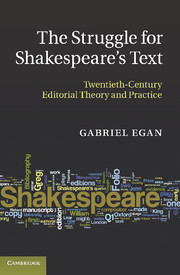Book contents
- Frontmatter
- Contents
- Preface
- Acknowledgements
- A note on references, quotations, names and pronouns
- Introduction
- 1 The fall of pessimism and the rise of New Bibliography, 1902–1942
- 2 New techniques and the Virginian School: New Bibliography 1939–1968
- 3 New Bibliography 1969–1979
- Intermezzo: the rise and fall of the theory of memorial reconstruction
- 4 New Bibliography critiqued and revised, 1980–1990
- 5 The ‘new’ New Bibliography: the Oxford Complete Works, 1978–1989
- 6 Materialism, unediting and version-editing, 1990–1999
- Conclusion: the twenty-first century
- Appendix 1 How early modern books were made: a brief guide
- Appendix 2 Table of Shakespeare editions up to 1623
- Appendix 3 Editorial principles of the major twentieth-century Shakespeare editions
- Works cited
- Index
Intermezzo: the rise and fall of the theory of memorial reconstruction
Published online by Cambridge University Press: 06 December 2010
- Frontmatter
- Contents
- Preface
- Acknowledgements
- A note on references, quotations, names and pronouns
- Introduction
- 1 The fall of pessimism and the rise of New Bibliography, 1902–1942
- 2 New techniques and the Virginian School: New Bibliography 1939–1968
- 3 New Bibliography 1969–1979
- Intermezzo: the rise and fall of the theory of memorial reconstruction
- 4 New Bibliography critiqued and revised, 1980–1990
- 5 The ‘new’ New Bibliography: the Oxford Complete Works, 1978–1989
- 6 Materialism, unediting and version-editing, 1990–1999
- Conclusion: the twenty-first century
- Appendix 1 How early modern books were made: a brief guide
- Appendix 2 Table of Shakespeare editions up to 1623
- Appendix 3 Editorial principles of the major twentieth-century Shakespeare editions
- Works cited
- Index
Summary
As we saw at the beginning of this narrative (pp. 12–15 above), the foundational act of the New Bibliography was A. W. Pollard's 1909 reinterpretation of the 1623 Folio preliminaries' reference to ‘stolne, and surreptitious copies’ as denoting not all the preceding quartos but only the bad ones produced by piracy: Romeo and Juliet (1597), Henry 5 (1600), The Merry Wives of Windsor (1602), Hamlet (1603) and Pericles (1609). The following year W. W. Greg identified a possible vector for piracy when he established that the quarto of The Merry Wives of Windsor has scenes containing the Host that are much closer to the Folio text than the rest, suggesting that the journeyman actor who took this role had a hand in making the quarto's copy by recalling his lines (Shakespeare 1910, vii–lvi). Necessarily, an actor's recollection of lines (especially his own) from scenes in which he was onstage and speaking would be better than his recollection of lines overheard from somewhere offstage, which would explain why the quarto becomes like the Folio, the authoritative text, when the Host enters and drifts away from it when he exits. At this early point in the life of the new hypothesis the other bad quartos stood in an unknown relation to the good versions that appeared in subsequent quarto and Folio editions, but over time all of them (and more) were claimed by adherents of memorial reconstruction.
- Type
- Chapter
- Information
- The Struggle for Shakespeare's TextTwentieth-Century Editorial Theory and Practice, pp. 100 - 128Publisher: Cambridge University PressPrint publication year: 2010



